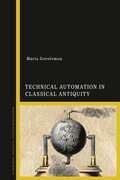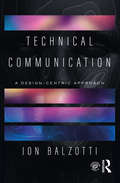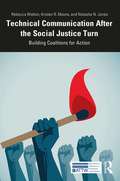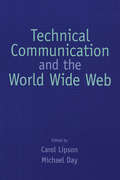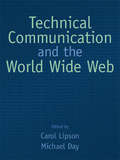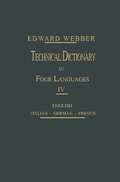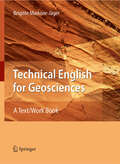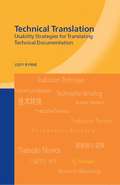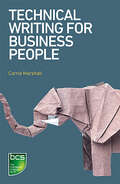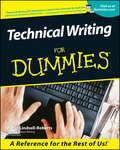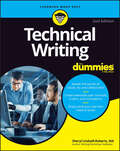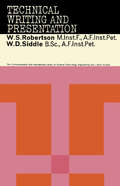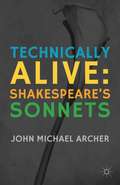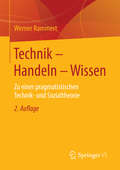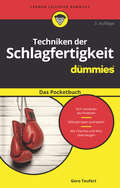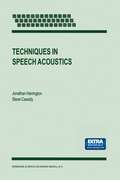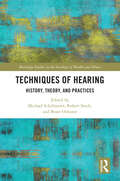- Table View
- List View
The Techlash and Tech Crisis Communication
by Nirit Weiss-BlattThis book provides an in-depth analysis of the evolution of tech journalism. The emerging tech-backlash is a story of pendulum swings: We are currently in tech-dystopianism after a long period spent in tech-utopianism. Tech companies were used to 'cheerleading' coverage of product launches. This long tech-press honeymoon ended, and was replaced by a new era of mounting criticism focused on tech's negative impact on society. When and why did tech coverage shift? How did tech companies respond to the rise of tech criticism? The book depicts three main eras: Pre-Techlash, Techlash, and Post-Techlash. The reader is taken on a journey from computer magazines, through tech blogs to the upsurge of tech investigative reporting. It illuminates the profound changes in the power dynamics between the media and the tech giants it covers. The interplay between tech journalism and tech PR was underexplored. Through analyses of both tech media and the corporates' crisis responses, this book examines the roots and characteristics of the Techlash, and provides explanations to 'How did we get here?'. Insightful observations by tech journalists and tech public relations professionals are added to the research data, and together - they tell the story of the TECHLASH. It includes theoretical and practical implications for both tech enthusiasts and critics.
The Techlash and Tech Crisis Communication
by Nirit Weiss-BlattThis book provides an in-depth analysis of the evolution of tech journalism. The emerging tech-backlash is a story of pendulum swings: We are currently in tech-dystopianism after a long period spent in tech-utopianism. Tech companies were used to 'cheerleading' coverage of product launches. This long tech-press honeymoon ended, and was replaced by a new era of mounting criticism focused on tech's negative impact on society. When and why did tech coverage shift? How did tech companies respond to the rise of tech criticism? The book depicts three main eras: Pre-Techlash, Techlash, and Post-Techlash. The reader is taken on a journey from computer magazines, through tech blogs to the upsurge of tech investigative reporting. It illuminates the profound changes in the power dynamics between the media and the tech giants it covers. The interplay between tech journalism and tech PR was underexplored. Through analyses of both tech media and the corporates' crisis responses, this book examines the roots and characteristics of the Techlash, and provides explanations to 'How did we get here?'. Insightful observations by tech journalists and tech public relations professionals are added to the research data, and together - they tell the story of the TECHLASH. It includes theoretical and practical implications for both tech enthusiasts and critics.
Technical Automation in Classical Antiquity
by Maria GerolemouTechnical automation – the ability of man-made (or god-made) objects to move and act autonomously – is not just the province of engineering or science fiction. In this book, Maria Gerolemou, by taking as her starting point the close semantic and linguistic relevance of technical automation to natural automatism, demonstrates how ancient literature, performance and engineering were often concerned with the way nature and artifice interacted. Moving across epic, didactic, tragedy, comedy, philosophy and ancient science, this is a brilliant assembly of evidence for the power of 'automatic theatre' in ancient literature. Gerolemou starts with the earliest Greek literature of Homer and Hesiod, where Hephaestus' self-moving artefacts in the Iliad reflect natural forces of motion and the manufactured Pandora becomes an autonomous woman. Her second chapter looks at Greek drama, where technical automation is used to augment and undermine nature not only through staging and costume but also in plot devices where statues come to life and humans behave as automatic devices. In the third chapter, Gerolemou considers how the philosophers of the 4th century BCE and the engineers of the Hellenistic period with their mechanical devices contributed to a growing dialogue around technical automation and how it could help its audience glance and marvel at the hidden mechanisms of self-motion. Finally, the book explores the ways technical automation is employed as an ekphrastic technique in late antiquity and early Byzantium.
Technical Automation in Classical Antiquity
by Maria GerolemouTechnical automation – the ability of man-made (or god-made) objects to move and act autonomously – is not just the province of engineering or science fiction. In this book, Maria Gerolemou, by taking as her starting point the close semantic and linguistic relevance of technical automation to natural automatism, demonstrates how ancient literature, performance and engineering were often concerned with the way nature and artifice interacted. Moving across epic, didactic, tragedy, comedy, philosophy and ancient science, this is a brilliant assembly of evidence for the power of 'automatic theatre' in ancient literature. Gerolemou starts with the earliest Greek literature of Homer and Hesiod, where Hephaestus' self-moving artefacts in the Iliad reflect natural forces of motion and the manufactured Pandora becomes an autonomous woman. Her second chapter looks at Greek drama, where technical automation is used to augment and undermine nature not only through staging and costume but also in plot devices where statues come to life and humans behave as automatic devices. In the third chapter, Gerolemou considers how the philosophers of the 4th century BCE and the engineers of the Hellenistic period with their mechanical devices contributed to a growing dialogue around technical automation and how it could help its audience glance and marvel at the hidden mechanisms of self-motion. Finally, the book explores the ways technical automation is employed as an ekphrastic technique in late antiquity and early Byzantium.
Technical Communication: A Design-Centric Approach
by Jon BalzottiTechnical Communication: A Design-Centric Approach is a comprehensive textbook for introductory courses in technical communication and professional writing. Technical Communication takes a design approach to foundational and emergent technical communication skills such as document design, job applications and interviews, workplace collaboration, and report writing, providing students with practical guidance on matters of ethics, style, and problem-solving in a range of professional and organizational contexts. This is a core textbook suitable for undergraduate courses in technical and professional communication.The book is supplemented by an innovative website featuring interactive simulations of various real-world technical communication challenges. Visit https://microcore.byu.edu/
Technical Communication: A Design-Centric Approach
by Jon BalzottiTechnical Communication: A Design-Centric Approach is a comprehensive textbook for introductory courses in technical communication and professional writing. Technical Communication takes a design approach to foundational and emergent technical communication skills such as document design, job applications and interviews, workplace collaboration, and report writing, providing students with practical guidance on matters of ethics, style, and problem-solving in a range of professional and organizational contexts. This is a core textbook suitable for undergraduate courses in technical and professional communication.The book is supplemented by an innovative website featuring interactive simulations of various real-world technical communication challenges. Visit https://microcore.byu.edu/
Technical Communication After the Social Justice Turn: Building Coalitions for Action (ATTW Series in Technical and Professional Communication)
by Rebecca Walton Kristen Moore Natasha JonesThis is the first scholarly monograph marking the social justice turn in technical and professional communication (TPC). Social justice often draws attention to structural oppression, but to enact social justice as technical communicators, first, we must be able to trace daily practice to the oppressive structures it professionalizes, codifies, and normalizes. Technical Communication After the Social Justice Turn moves readers from conceptual explorations of oppression and justice to a theoretical framework that allows for the concepts to be applied and implemented in a variety of practical contexts. It historicizes the recent social justice turn in TPC scholarship, models a social justice approach to building theories and heuristics, and presents scenarios that illustrate how to develop sustainable practices of activism and social justice. Its commitment to coalition building, inclusivity, and socially just practices of citation and activism will support scholars, teachers, and practitioners not only in understanding how the work of technical communication is often complicit in oppression but also in recognizing, revealing, rejecting, and replacing oppressive practices.
Technical Communication After the Social Justice Turn: Building Coalitions for Action (ATTW Series in Technical and Professional Communication)
by Rebecca Walton Kristen Moore Natasha JonesThis is the first scholarly monograph marking the social justice turn in technical and professional communication (TPC). Social justice often draws attention to structural oppression, but to enact social justice as technical communicators, first, we must be able to trace daily practice to the oppressive structures it professionalizes, codifies, and normalizes. Technical Communication After the Social Justice Turn moves readers from conceptual explorations of oppression and justice to a theoretical framework that allows for the concepts to be applied and implemented in a variety of practical contexts. It historicizes the recent social justice turn in TPC scholarship, models a social justice approach to building theories and heuristics, and presents scenarios that illustrate how to develop sustainable practices of activism and social justice. Its commitment to coalition building, inclusivity, and socially just practices of citation and activism will support scholars, teachers, and practitioners not only in understanding how the work of technical communication is often complicit in oppression but also in recognizing, revealing, rejecting, and replacing oppressive practices.
Technical Communication and the World Wide Web
by Carol Lipson Michael DayOver the past decade, the World Wide Web has dramatically changed the face of technical communication, but the teaching of writing has thus far altered very little to accommodate this rapidly changing context. Technical Communication and the World Wide Web offers substantial and broadly applicable strategies for teaching global communication issues affecting writing for the World Wide Web.Editors Carol Lipson and Michael Day have brought together an exceptional group of experienced and well-known teacher-scholars to develop this unique volume addressing technical communication education. The chapters here focus specifically on curriculum issues and the teaching of technical writing for the World Wide Web, contributing a blend of theory and practice in proposing changes in curriculum and pedagogy. Contributors offer classroom examples that teachers at all levels of experience can adapt for their own classes. The volume provides comprehensive coverage of the technical communication curriculum, from the two-year level to the graduate level; from service courses to degree programs.This volume is an important and indispensable resource for technical writing educators, and it will serve as an essential reference for curriculum and pedagogy development in technical communication programs.
Technical Communication and the World Wide Web
by Carol Lipson Michael DayOver the past decade, the World Wide Web has dramatically changed the face of technical communication, but the teaching of writing has thus far altered very little to accommodate this rapidly changing context. Technical Communication and the World Wide Web offers substantial and broadly applicable strategies for teaching global communication issues affecting writing for the World Wide Web.Editors Carol Lipson and Michael Day have brought together an exceptional group of experienced and well-known teacher-scholars to develop this unique volume addressing technical communication education. The chapters here focus specifically on curriculum issues and the teaching of technical writing for the World Wide Web, contributing a blend of theory and practice in proposing changes in curriculum and pedagogy. Contributors offer classroom examples that teachers at all levels of experience can adapt for their own classes. The volume provides comprehensive coverage of the technical communication curriculum, from the two-year level to the graduate level; from service courses to degree programs.This volume is an important and indispensable resource for technical writing educators, and it will serve as an essential reference for curriculum and pedagogy development in technical communication programs.
Technical Translation: Usability Strategies for Translating Technical Documentation
by Jody ByrneThis introduction to technical translation and usability draws on a broad range of research and makes the topic both accessible and applicable to those involved in the practice and study of translation. Readers learn how to improve and assess the quality of technical translations using cognitive psychology, usability engineering and technical communication. A practical usability study illustrates the theories, methods and benefits of usability engineering.
Technical Writing for Business People
by Carrie MarshallTechnical writing is about communicating key information to the people who need it. It might be a manual for an application, a guide to using heavy machinery, a diagnostic aide for medical practitioners or a guidance note about new legislation. It needs to be clear and it needs to be precise. This book shows you how to achieve this and more. Whatever the content or context, in this book you’ll discover the essential tools and resources that you need to create technical writing that works for everyone.
Technical Writing for Business People
by Carrie MarshallTechnical writing is about communicating key information to the people who need it. It might be a manual for an application, a guide to using heavy machinery, a diagnostic aide for medical practitioners or a guidance note about new legislation. It needs to be clear and it needs to be precise. This book shows you how to achieve this and more. Whatever the content or context, in this book you’ll discover the essential tools and resources that you need to create technical writing that works for everyone.
Technical Writing For Dummies (For Dummies Ser.)
by Sheryl Lindsell-RobertsLet’s face it, a lot of technical documentation reads as if it had been translated into English from Venutian by a native speaker of gibberish. Which is annoying for you and expensive for the manufacturer who pays with alienated customers and soaring technical support costs. That’s why good technical writers are in such big demand worldwide. Now, Technical Writing For Dummies arms you with the skills you need to cash in on that demand. Whether you’re contemplating a career as a technical writer, or you just got tapped for a technical writing project, this friendly guide is your ticket to getting your tech writing skills up to snuff. It shows you step-by-step how to: Research and organize information for your documents Plan your project in a technical brief Fine-tune and polish your writing Work collaboratively with your reviewers Create great user manuals, awesome abstracts, and more Write first-rate electronic documentation Write computer- and Web-based training courses Discover how to write energized technical documents that have the impact you want on your readers. Wordsmith Sheryl Lindsell-Roberts covers all the bases, including: All about the red-hot market for technical writing and how to get work as a technical writer The ABCs of creating a strong technical document, including preparing a production schedule, brainstorming, outlining, drafting, editing, rewriting, testing, presentation, and more Types of technical documents, including user manuals, abstracts, spec sheets, evaluation forms and questionnaires, executive summaries, and presentations Writing for the Internet—covers doing research online, creating multimedia documents, developing computer-based training and Web-based training, and writing online help Combining examples, practical advice, and priceless insider tips on how to write whiz-bang technical documents, Technical Writing For Dummies is an indispensable resource for newcomers to technical writing and pros looking for new ideas to advance their careers.
Technical Writing For Dummies
by Sheryl Lindsell-RobertsLearn to document the technology that makes the world go Technical Writing For Dummies is a master class on how to build a career writing user manuals, e-learning, streaming, simulations, and more. It even zooms into the metaverse. Whether you’re new to the field, a seasoned professional, or a technical person who needs to write, this guide arms you with the skills you need to cash in on this flourishing world of technical writing. This isn’t your average how-to. It’s a compendium of innovative industry knowledge that will help you set yourself apart with the latest trends and best practices in technical writing. As a tech writer, you’ll need a robust skillset that allows you to offer clear and concise documentation for just about anything. This new edition of Technical Writing For Dummies—updated for all of today’s tech writing advances—can get you there. Uncover the basics of technical writing and master common documentation types Get insight into the career paths available to tech writers today Discover new remote collaboration options and cloud-based tools for technical writers Learn how to elevate your documents for high search engine optimization (SEO) rankings Improve your craft to connect with diverse, global audiencesWhether you’re a technical writer or technical professional who needs to write—you can learn the best practices of effective technical writing, as well as how to navigate its various formats and platforms, thanks to this handy Dummies guide.
Technical Writing For Dummies
by Sheryl Lindsell-RobertsLearn to document the technology that makes the world go Technical Writing For Dummies is a master class on how to build a career writing user manuals, e-learning, streaming, simulations, and more. It even zooms into the metaverse. Whether you’re new to the field, a seasoned professional, or a technical person who needs to write, this guide arms you with the skills you need to cash in on this flourishing world of technical writing. This isn’t your average how-to. It’s a compendium of innovative industry knowledge that will help you set yourself apart with the latest trends and best practices in technical writing. As a tech writer, you’ll need a robust skillset that allows you to offer clear and concise documentation for just about anything. This new edition of Technical Writing For Dummies—updated for all of today’s tech writing advances—can get you there. Uncover the basics of technical writing and master common documentation types Get insight into the career paths available to tech writers today Discover new remote collaboration options and cloud-based tools for technical writers Learn how to elevate your documents for high search engine optimization (SEO) rankings Improve your craft to connect with diverse, global audiencesWhether you’re a technical writer or technical professional who needs to write—you can learn the best practices of effective technical writing, as well as how to navigate its various formats and platforms, thanks to this handy Dummies guide.
Technical Writing & Presentation: The Commonwealth and International Library: Social Administration, Training, Economics, and Production Division
by W. S. Robertson W. D. SiddleTechnical Writing and Presentation is a guide to writing reports and articles for presentation to technical people or to the scientific community. The book deals with the special requirements in writing technical and highly specialized reports. The book covers the complete phase from planning the work to be done to finally editing the manuscript. To start writing, the writer aims to have a clear objective and properly identifies his kind of readership. Then the author provides tips on gathering information and how to arrange these in standard sequences. The author then discusses the style of writing, choice of words and sentences, paragraph length, use of appropriate jargon and clichés and the use of passive construction of sentences. After providing some examples of good writing, the book addresses the importance of a good layout. This includes margins, spacing, headings, and preparing the manuscript. The use of illustrations, tone drawings, graphs, and photographs is discussed. The book then focuses on the editing process when the writer reviews his own work objectively. The text also gives tips on editing procedures as well as miscellaneous problems (use of copyrighted materials, footnotes, and references). Many scientists, researchers, technologists, students, and academic professors who have to write articles and papers of a technical nature will find this book handy.
Technically Alive: Shakespeare’s Sonnets
by J. ArcherDrawing on the later writings of Martin Heidegger, the book traces the correspondence between the philosopher's concept of technology and Shakespeare's poetics of human and natural productivity in the Sonnets.
Technik - Handeln - Wissen: Zu einer pragmatistischen Technik- und Sozialtheorie
by Werner RammertDas Anliegen dieses Buches ist es, die Lücke mangelnden Technikbezugs in der Sozial- und Gesellschaftstheorie zu füllen. Dazu werden mit Bezug auf Technik-, Medien-, Symbol- und Interaktionstheorien und speziell Ansätze der Praxistheorie von Dewey, Mead, Joas und Giddens konzeptuelle Vorschläge gemacht. An Beispielen wird gezeigt, wie mit diesen Konzepten der Technisierung, der soziotechnischen Konstellation und der hybriden Handlungsträgerschaft von Mensch, Maschine und Programm die Soziologie für die Analyse von Interaktivitäten mit Softwareagenten und Suchmaschinen, mit Robotern und autonomen Fahrzeugen fit gemacht werden kann. Wegen der Synthese techniksoziologischen Wissens kann es auch als Einführung in die Techniksoziologie für Fortgeschrittene und Interessierte anderer Fächer gelesen werden.
Techniken der Schlagfertigkeit für Dummies Das Pocketbuch (Für Dummies)
by Gero TeufertFühlen Sie sich manchmal sprachlos bei Vorwürfen, kritischen Fragen, Killerphrasen oder verbalen Tiefschlägen im Beruf oder Privatleben? "Techniken der Schlagfertigkeit für Dummies" hilft Ihnen, auf verbale Attacken witzig, wortgewandt und rhetorisch überlegen zu reagieren und selbst dann noch angemessen zu kontern, wenn der Gesprächspartner unter die Gürtellinie zielt. Gezielte Techniken ermöglichen es Ihnen, Ihre Konter- und Assoziationsfähigkeit schrittweise zu stärken. So können Sie mit Standardsätzen selbst in Stresssituationen schlagfertige Antworten aus dem Ärmel schütteln. Lernen Sie souverän zu reagieren und dabei Humor ins Spiel zu bringen. Überwinden Sie Ihre Sprachlosigkeit, zücken Sie den verbalen Degen und schlagen Sie zurück!
Techniques in Speech Acoustics (Text, Speech and Language Technology #8)
by J. Harrington S. CassidyTechniques in Speech Acoustics provides an introduction to the acoustic analysis and characteristics of speech sounds. The first part of the book covers aspects of the source-filter decomposition of speech, spectrographic analysis, the acoustic theory of speech production and acoustic phonetic cues. The second part is based on computational techniques for analysing the acoustic speech signal including digital time and frequency analyses, formant synthesis, and the linear predictive coding of speech. There is also an introductory chapter on the classification of acoustic speech signals which is relevant to aspects of automatic speech and talker recognition. The book intended for use as teaching materials on undergraduate and postgraduate speech acoustics and experimental phonetics courses; also aimed at researchers from phonetics, linguistics, computer science, psychology and engineering who wish to gain an understanding of the basis of speech acoustics and its application to fields such as speech synthesis and automatic speech recognition.
Techniques of Hearing: History, Theory and Practices
by Michael Schillmeier, Robert Stock, and Beate OchsnerHearing, health and technologies are entangled in multi-faceted ways. The edited volume addresses this complex relationship by arguing that modern hearing was and is increasingly linked to and mediated by technological innovations. By providing a set of original interdisciplinary investigations that sheds new light on the history, theory and practices of hearing techniques, it is able to explore the heterogeneous entanglements of sound, hearing practices, technologies and health issues. As the first book to bring together historians, scholars from media studies, social sciences, cultural studies, acoustics and neuroscientists, the volume discusses modern technologies and their decisive impact on how ‘normal’ hearing, enhanced and smart hearing as well as hearing impairment have been configured. It brings both new insights into the histories of hearing technologies as well as allowing us to better understand how enabling hearing technologies have currently been unfolding an increasingly hybrid ecology engaging smart hearing devices and offering stress-free hearing and acoustic wellbeing in novel auditory environments. The volume will be of interest to all scholars and students of disability studies, sound studies, sociology of health and illness, medical history, health and society as well as those interested in the practices and techniques of self-monitored and smart hearing.
Techniques of Hearing: History, Theory and Practices
by Michael Schillmeier Robert Stock Beate OchsnerHearing, health and technologies are entangled in multi-faceted ways. The edited volume addresses this complex relationship by arguing that modern hearing was and is increasingly linked to and mediated by technological innovations. By providing a set of original interdisciplinary investigations that sheds new light on the history, theory and practices of hearing techniques, it is able to explore the heterogeneous entanglements of sound, hearing practices, technologies and health issues. As the first book to bring together historians, scholars from media studies, social sciences, cultural studies, acoustics and neuroscientists, the volume discusses modern technologies and their decisive impact on how ‘normal’ hearing, enhanced and smart hearing as well as hearing impairment have been configured. It brings both new insights into the histories of hearing technologies as well as allowing us to better understand how enabling hearing technologies have currently been unfolding an increasingly hybrid ecology engaging smart hearing devices and offering stress-free hearing and acoustic wellbeing in novel auditory environments. The volume will be of interest to all scholars and students of disability studies, sound studies, sociology of health and illness, medical history, health and society as well as those interested in the practices and techniques of self-monitored and smart hearing.


